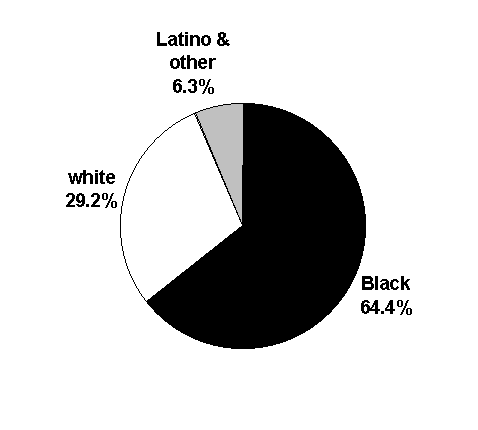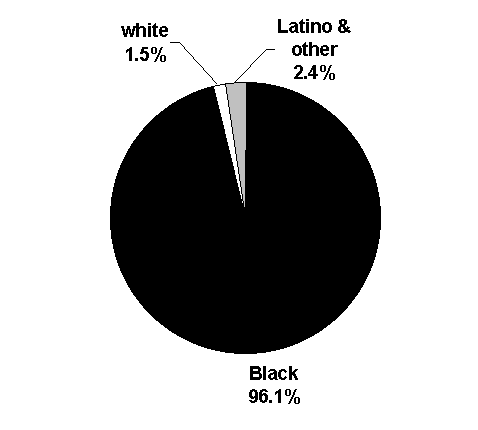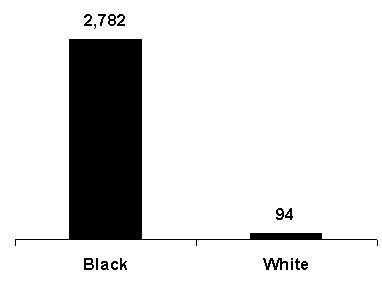As of August 1, 1997, 96.1% of Washington, D.C. prisoners are Black, and only 1.5% are non-Hispanic white.(1) We calculate imprisonment rates per 100,000 as 2,782 for Blacks and 94 for whites (combining men and women).(4) The overall U.S. Black incarceration rate was 1,947 per 100,000 in 1992-1993, and 306 for whites.(3) This means the Black imprisonment rates are worse in D.C. than in the rest of the country, and much lower for whites.


Unlike most of the country, Washington had a declining prison population from 1992 to 1996. This is probably the result of a weak government and police force. The number of sworn police officers fell from 5,679 in 1991 to 3,815 in 1995 (the most recent number we found), so there were less people to make arrests. From 1992 to 1996 the number of prisoners per 100,000 population dropped by 12%, from 1,973 to 1,739. However, in 1997 the rate bounced back up 6%, to 1,841.(1) This counts all prisoners, while the Federal government's lower "prison incarceration rate" (1,373 in 1997) includes only those sentenced to a year or more.(2)

Another sign of a weak local police and injustice system could be the shift from arresting people for dealing drugs to arresting people for using drugs. From 1992 to 1996, the percent of adult drug arrests for sales dropped from 35 to 13, while possession arrests rose from 65% to 86% of adult drug arrests -- all while the total number of drug arrests didn't change much.(1) For whatever reason, this just means more persecution of people for drug use or alleged drug use, more repression of people who should not be considered criminals at all.
The juvenile imprisonment rates are just as unequal. In a 1995 one-day count, the juvenile (ages 10-17) "custody" rate was 910 per 100,000 -- 1,992 for Black men, 269 for Black women, 326 for white men, and 0 for white women.(1)
RAIL argues that the whole injustice system is an oppression machine, especially targeting the oppressed Black, Latino and First Nations. We also acknowledge that some people in prison have done bad things and need to shape up -- it's just that the worst criminals are in government and corporate boardrooms, not in jail. Still, talking to people on the street it's clear that most don't realize that a majority of prisoners are not there for violent crimes. In D.C., 53% of inmates were sentenced for non-violent crimes.(1) But even that is misleading, because a lot of "violent" crimes only included the threat of violence. Only 3% of all arrests are on charges of a violent crime that resulted in injury.(3) In D.C., 29% of adults in prison are there in for narcotics charges alone -- that's almost 3,000 people in prison for drugs in this city.(1)
Washington shows an extreme form of the oppressive nature of Amerika's criminal injustice system, made worse by the lack of even basic democracy for the Black D.C. majority and the economic isolation of the city that results. DC-RAIL urges people to get involved with the local work to end the Amerikan lockdown. Contact us at: rail@mim.org.
Notes:
1. Crime and Justice Trends in the District of Columbia. National Council on Crime and Delinquency. Washington, D.C., Fall 1997.
2. Prison and Jail Inmates at Midyear 1997. Bureau of Justice Statistics Bulletin, January 1998 (NCJ-167247).
3. The Real War on Crime: The Report of the National Criminal Justice Commission, edited by Stephen R. Donziger (HarperCollins, 1996).
4. The Census Bureau has 1997 population estimates for D.C., but the most recent "race"-specific estimates are for 1996. So we assume the 1996-1997 population change was equal for Blacks and whites; it wasn't a big change anyway.
![]()